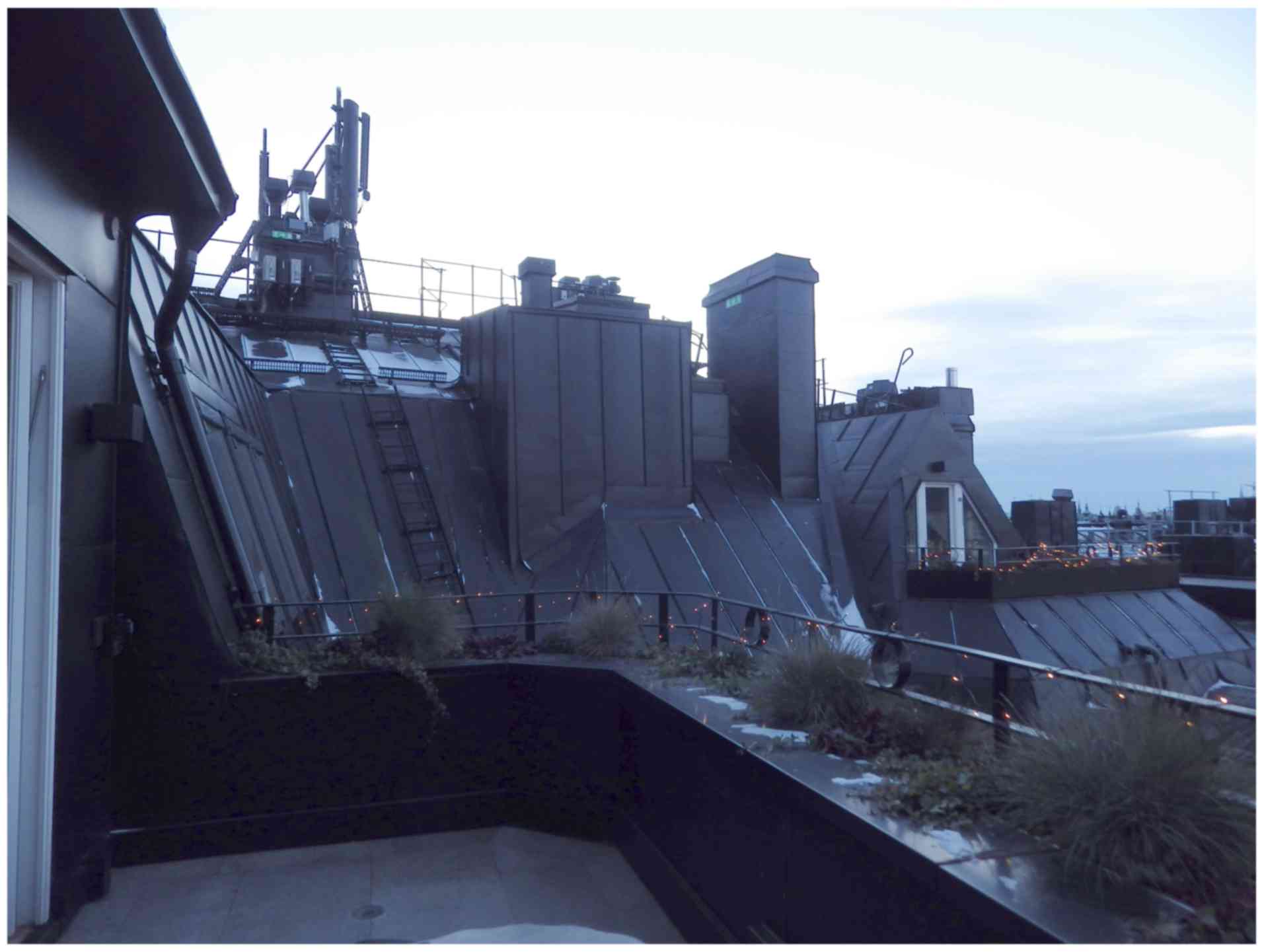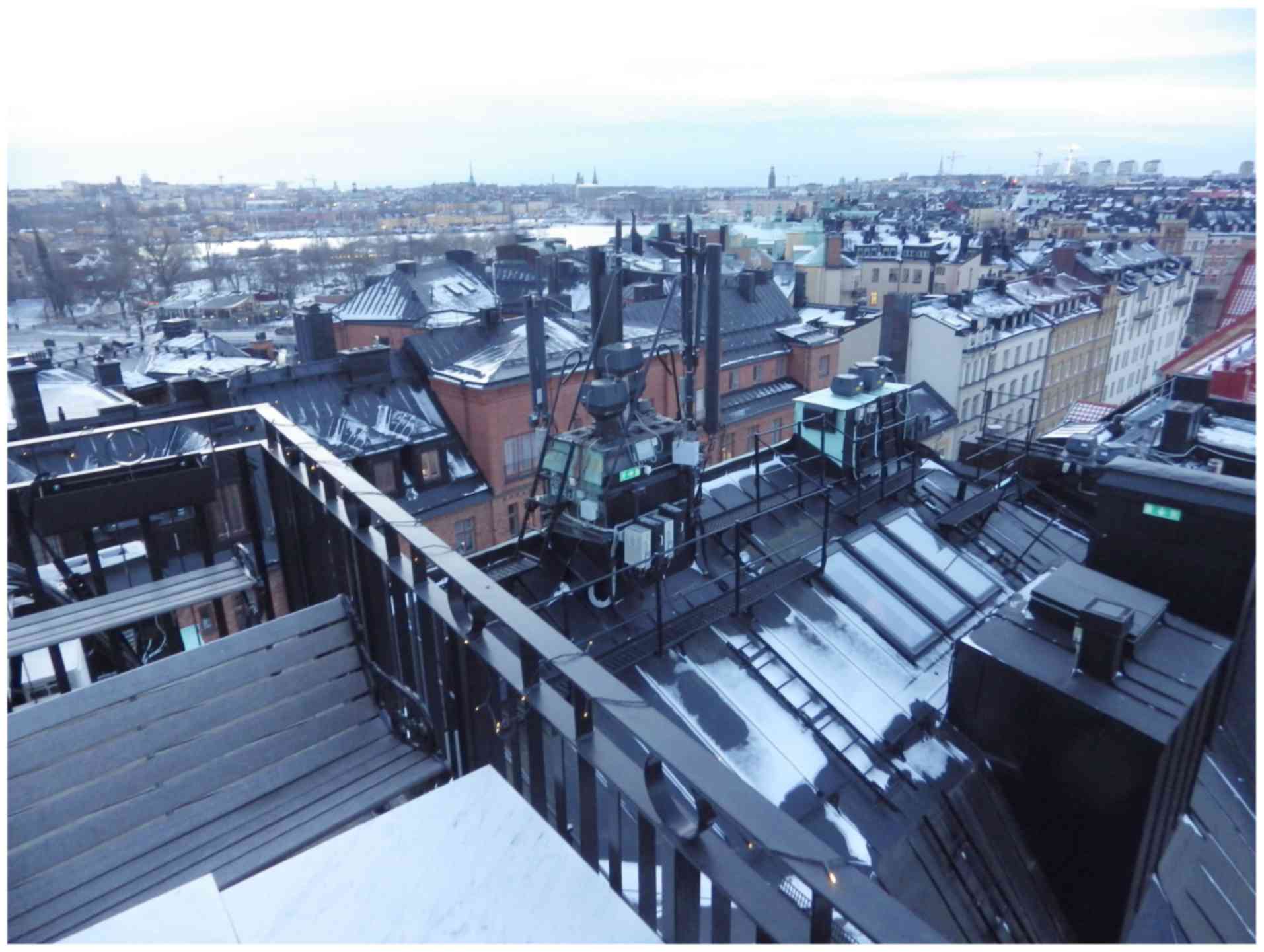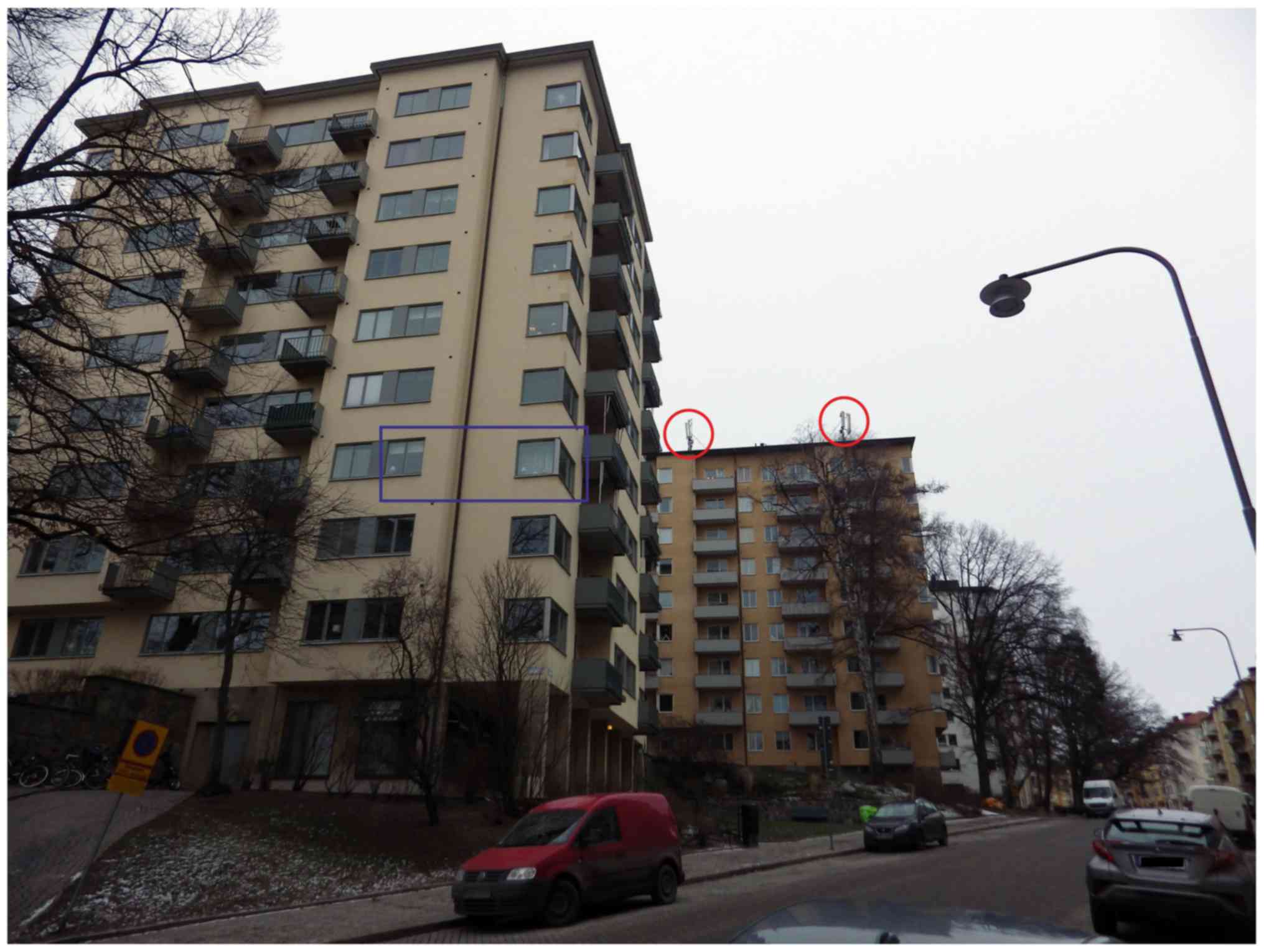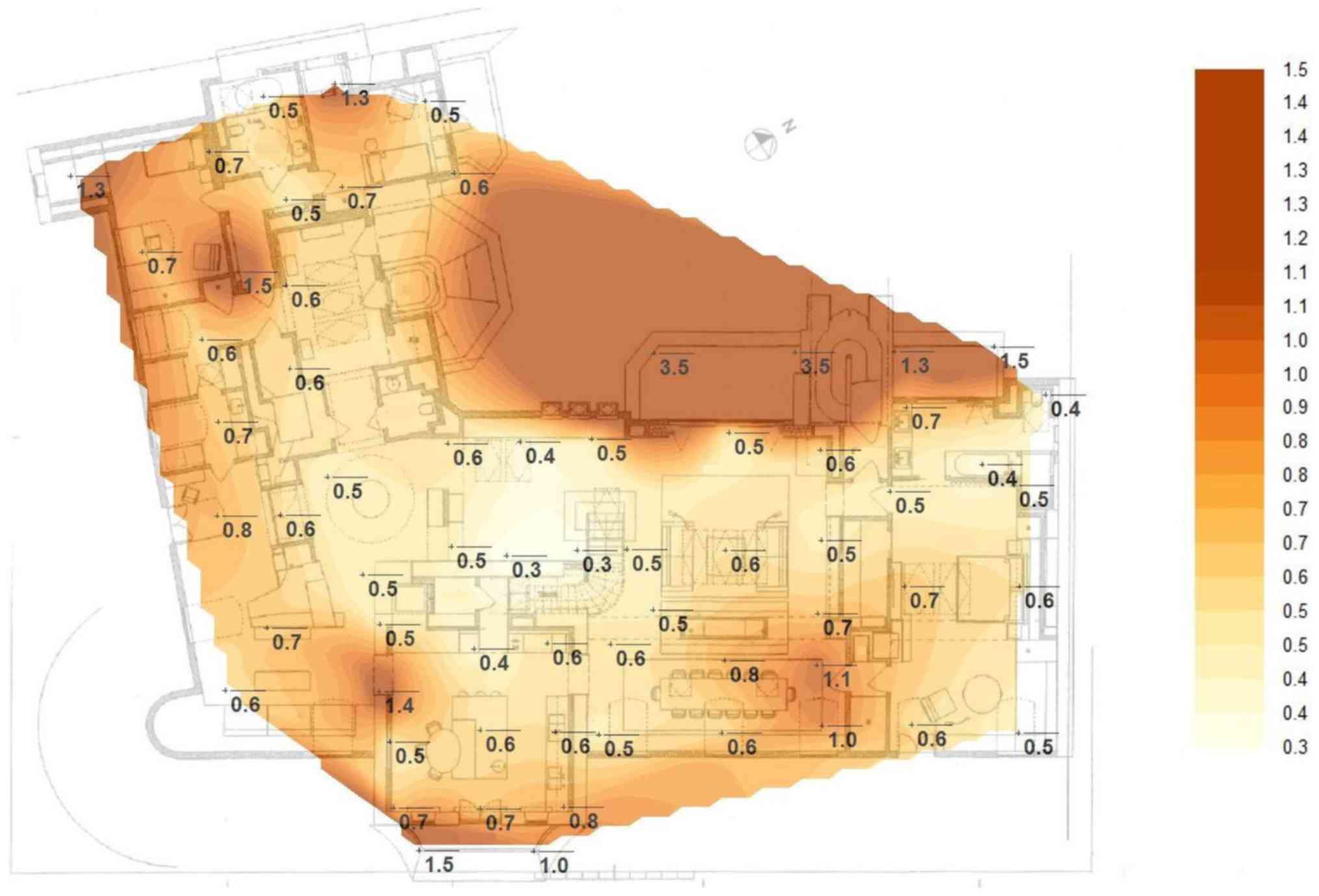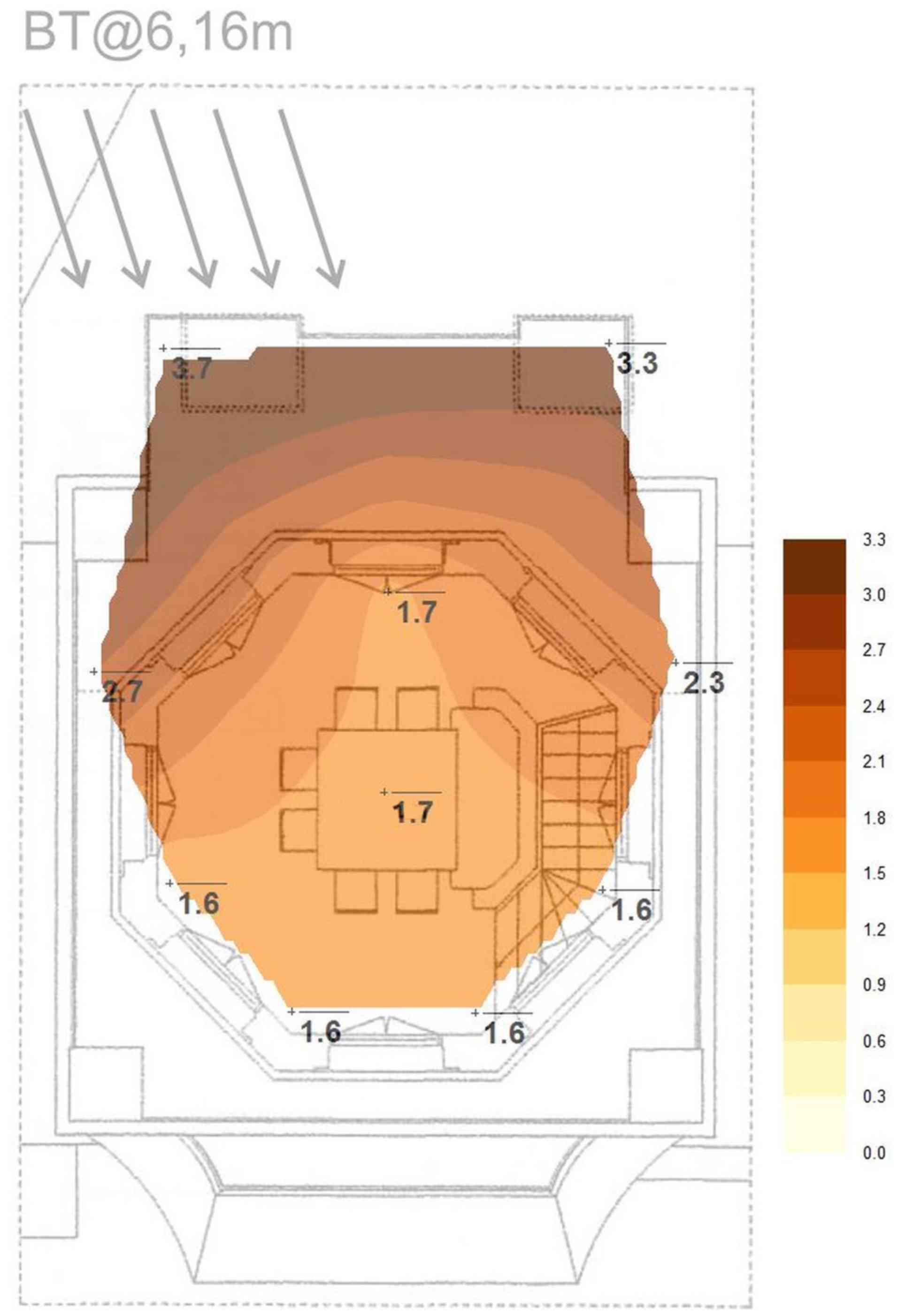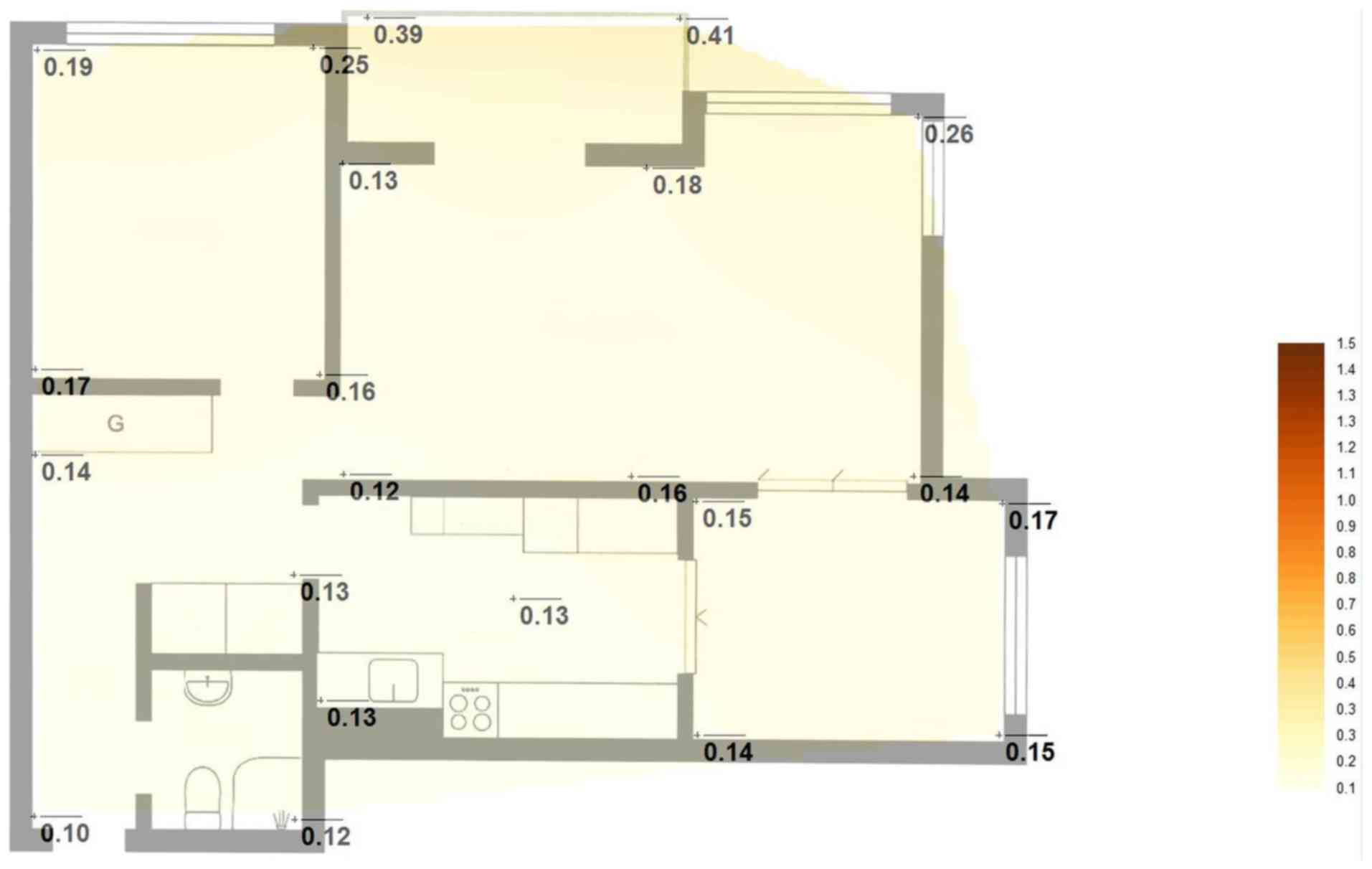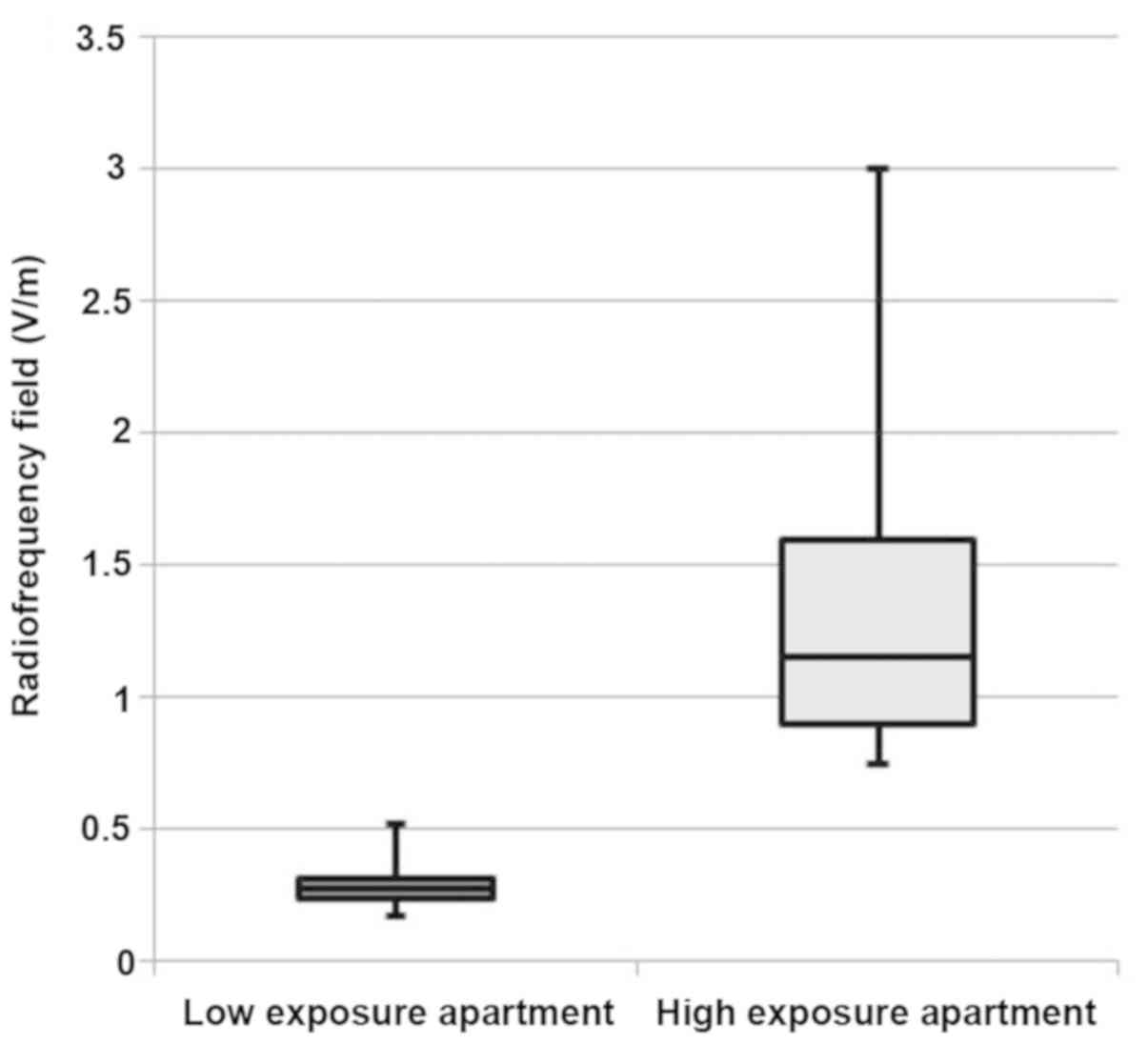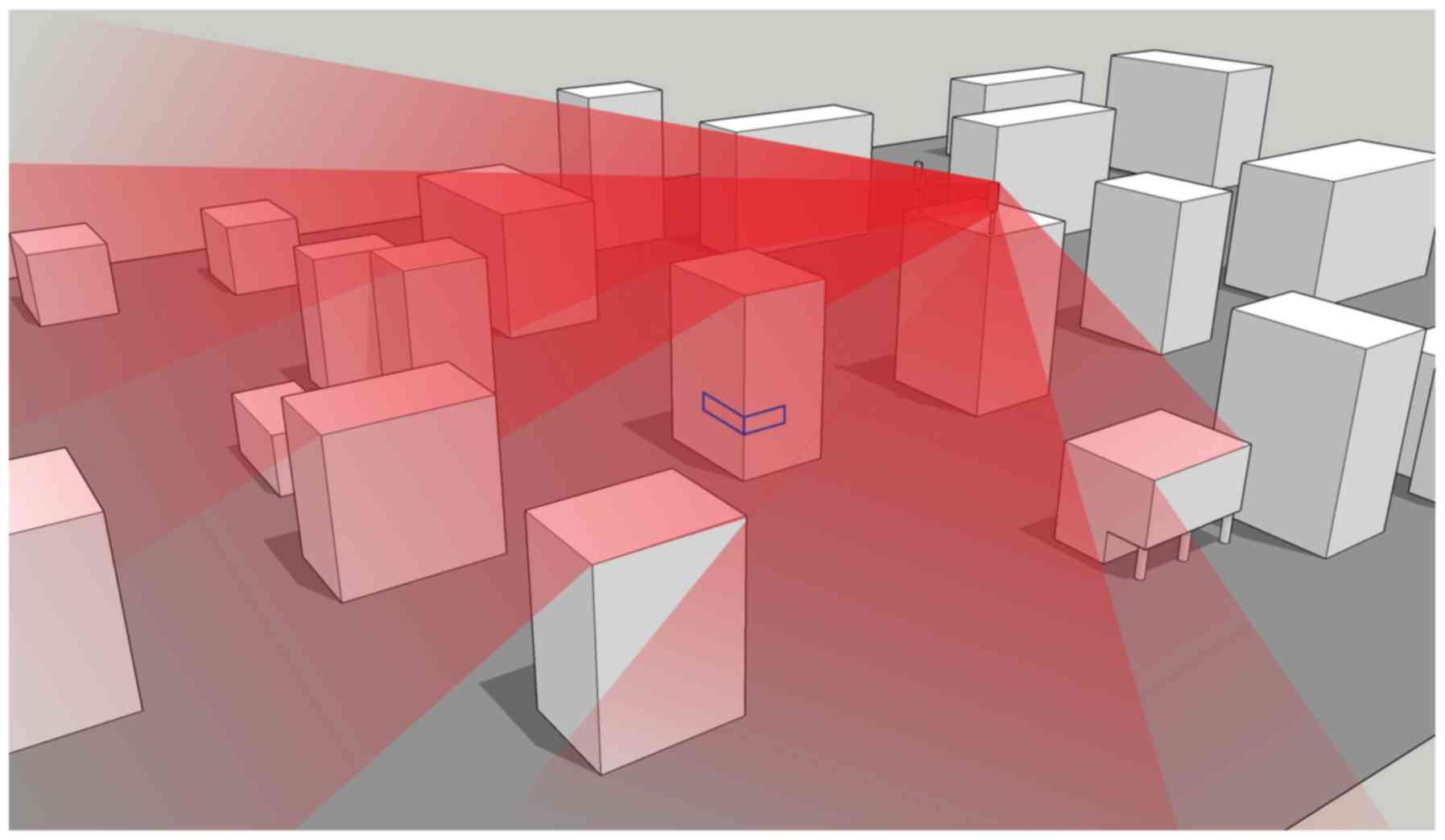Introduction
Public exposure to radiofrequency (RF)
electromagnetic fields (EMF) in today's cities may be caused by a
number of sources, including mobile phone base stations, TV and
radio towers, wireless local area networks (WLAN), emergency
services radio network, RF-identification systems, microwave ovens,
anti-theft gates etc. Additionally, individual's exposure may be
significantly elevated by personal usage of mobile and cordless
phones, 2-way radios, WLAN, Bluetooth and other wireless devices.
In this study we have focused on the exposure from mobile phone
base station antennas. Exposure in two apartments positioned close
to mobile phone base station antennas is measured in detail.
Developments in telecommunications technologies have
led to widespread use of mobile devices connected to the network in
constantly increasing loads. This has resulted also in the public's
exposure to RF EMFs. Temporal trends in RF EMF exposure in everyday
environments were investigated across European cities of Basel,
Ghent and Brussels in 2011–2012 (1).
Within a year total RF exposure levels in all investigated outdoor
locations combined raised 57.1%. The increase in exposure was most
notably observed in outdoor locations due to mobile phone base
stations (1).
In many European countries on-site RF exposure
measurements have been conducted since the 1990's. Most studies
have focused on the mobile communications' frequency bands. A
comparative analysis concluded that due to the developments in
telecommunications technology, the RF exposure is continuously
increasing and is estimated >65% of the total exposure (2). Based on the personal exposure
measurements in the EU, the mean RF is generally from 0.10 to 0.26
V m−1; however most of these studies are based on
outdoor measurements.
RF field exposure literature in Europe was reviewed,
comparing indoor levels to outdoor levels (3). The mean RF exposure from spot
measurements in homes was determined to be 0.29 V m−1
and for outdoor 0.54 V m−1. In outdoor studies the
exposure levels rarely exceeded 1.0 V m−1, whereas the
highest exposure contributor was the downlink i.e., radiation from
mobile phone base station antenna. A finding of the systematic
review was that there was no distinct difference in exposure levels
between European countries. However, studies done by different
researchers across the Europe have used different procedures
limiting the comparability between studies (3).
RF levels are exponentially higher when located
closer to the mobile phone base station antenna. Therefore, proper
safety measures must be applied when protecting public from the
excess RF radiation. One of the main safety principles is creating
sufficient distance between the public and the RF sources. This
requirement may not be met in certain housing conditions. Mobile
phone base stations installed on rooftops may become very close to
people in nearby apartments.
RF field exposure from a mobile phone base station
antenna, located at the rooftop showed that allowable maximum
safety levels were exceeded when being closer than 30 m to the base
station antenna (4). With the
increasing distance, the RF power density is increasingly affected
by the landscape topography, buildings, and trees that induce
reflection and absorption. Also, RF power density depends on the
numbers of channels in use by the base station antenna, the number
of time intervals used and other mobile communication specific
factors. The base station's maximum RF level varies across the day,
which is an indicator of the mobile communications' service load.
Also, RF power density distribution is greatly determined by the
antenna's directional pattern. Values were measured highest in the
balconies within the main radiation lobe of the antenna (4).
We have previously reported results from our
measurements of RF radiation levels at certain places in Stockholm,
Sweden such as at the Central Railway station (5), the Old Town (6), and in the City (7). High radiation was measured at a square,
Järntorget, in the Old Town as further displayed in a recent
publication displaying RF E-field distribution (8). Most of the radiation was downlink.
Of special concern is our results of measurements in
a Stockholm apartment for everyday living purposes (9). Two groups of base stations are located
close to the apartment. The total mean RF radiation level was 3,811
µW/m2 (range 15.2–112,318 µW/m2) for the
measurement of the whole apartment, including balconies.
Particularly high levels were measured on three balconies and in 3
of 4 bedrooms. High mean exposure levels in the bedrooms of growing
children (one at 2,531 µW/m2 and the other at 1,471
µW/m2) with maximum peaks at 11,803 and 13,739
µW/m2, respectively, may have deleterious effects on
their physical and mental health (9,10).
The aim of this study was to further investigate
radiation levels in the high exposure apartment (9) and to compare it with a low exposure
apartment showing RF E-field distribution. This was a measurement
study with no involvement of test persons. Thus, no ethical
permission was needed.
Materials and methods
In the present study RF field levels were
investigated in two apartments near mobile phone base station
antennas. One of the apartments represented a high exposure living
area, while the other was of low exposure area. Both of the
apartments were near to mobile phone base stations but located at
different city districts in Stockholm, Sweden. The locations of the
base stations close to the apartment with high RF radiation
exposure are shown in Figs. 1 and
2, whereas the base stations
relating to the low exposure apartment are shown in Fig. 3.
The high exposure apartment's outdoor areas were
positioned close to the mobile phone base station antennas, being
as close as 6 m. The low exposure apartment's balcony was about 40
m away from the base station antennas, since these were installed
on the neighboring building and significantly higher on the
roof.
Field spatial distribution measurements were
conducted in the investigated apartments. The following analyses
bring forth the low and high exposure determinant factors. RF
electric field was measured at each room of the apartments.
Depending on the room size, the room was divided into two to ten
quadrants (smaller imaginary squares). At each quadrant a spot
measurement was conducted. At each spot the field was measured with
slow circular movements to cover the area of about 1 m2
at heights of 0.7–2 m. At each spot, the average and maximum
electric field in Volts per meter (V m−1) was recorded
representing the measurement period of about 1 min.
The measurements were conducted on a working day
during business hours (afternoon) in January 2019.
Field perturbation by the measurer was minimized by
distancing the meter from the body-the meter was held at arm's
length, with the extending probe outward. The measurements area was
therefore at about 0.8–0.9 m from the investigator.
Spot distance to mobile phone base station antenna
was measured by targeting the closest antenna element. Distance was
measured by laser distance meter STABILA LE50, which provides
precise distance measurements up to 100 m with the resolution of
0.001 m at the accuracy ±1.5 mm/m.
The measurements were conducted with a RF broadband
analyzer, Narda NBM-520, with a E-field probe E0391
(Narda-Safety-Test-Solutions GmbH, Pfullingen, Germany). The Narda
NBM-series meter is capable of time and spatial averaging and
determining the maximum level during the period monitored. Narda
EF0391 probe is intended by the manufacturer for base station
measurements and has a frequency range from 100 kHz to 3 GHz.
The broadband meter Narda EF0391 covers a large
range of RF transmissions, including different telecommunications
protocols: frequency modulation (FM) radio broadcasting; television
(TV) broadcasting; TETRA emergency services (police, rescue, etc.);
global system for mobile communications (GSM) second generation
mobile communications; universal mobile telecommunications systems
(UMTS) third generation mobile communications, 3G; long-term
evolution (LTE) fourth generation mobile communications standard,
4G; digital European cordless telecommunications (DECT) cordless
telephone systems standard; Wi-Fi wireless local area network
protocol, 2.45 GHz; worldwide interoperability for microwave access
(WIMAX) wireless communication standard for high speed voice, data
and internet.
Mobile communications' service coverage reception
level was confirmed using an Android mobile phone, showing service
coverage in decibel milliwatts (dBm).
In the present study, measurement data are presented
both in tables and visual views. Spatial distribution of the RF
levels is presented in a heat map view. Heat map is possible only
by a volume of spatially scattered spot measurements. Heat map is
also seen by some other authors as a way to communicate the
measurements data in a comprehensible way to the public (11).
The measurement data, specifically average spot
measurement values, were entered to the contour map software
3DFIELD ver. 4.5.2.0 (by Vladimir Galouchko) and spatial field
distribution maps were drawn. Field distribution maps were based on
the spot measurements using 1 min time averaging.
Conversion from V m−1, to
W/m2, see also Table I.
In most of our earlier studies we have used the EME Spy 200 from
Satimo and preferred to show our results in power flux density in
W/m2 and µW/m2 for RF radiation. In the
current measurements the broadband analyzer Narda NBM-520 measures
in V m−1 and the contour map software 3DFIELD is also
constructed for measurements in V m−1.
 | Table I.Conversion table from E, Electric
field strength in V m−1 to S, power flux density in
µW/m2. |
Table I.
Conversion table from E, Electric
field strength in V m−1 to S, power flux density in
µW/m2.
| E in V
m−1 | S in
µW/m2 |
|---|
| 3.3 | 28,902 |
| 3.0 | 23,886 |
| 2.7 | 19,348 |
| 2.4 | 15,287 |
| 2.1 | 11,704 |
| 1.8 | 8,599 |
| 1.7 | 7,670 |
| 1.6 | 6,794 |
| 1.5 | 5,971 |
| 1.4 | 5,202 |
| 1.3 | 4,485 |
| 1.2 | 3,822 |
| 1.1 | 3,211 |
| 1.0 | 2,654 |
| 0.9 | 2,150 |
| 0.8 | 1,698 |
| 0.7 | 1,300 |
| 0.6 | 955 |
| 0.5 | 663 |
| 0.4 | 425 |
| 0.3 | 239 |
| 0.2 | 106 |
| 0.1 | 26 |
To convert from electric field strength, E, in V
m−1 to power flux density in W/m2, S, use the
formula: S=0.002654 × E2
Statistical methods
The data was analyzed using the spreadsheet software
Microsoft Excel 2016, calculating mean, median, minimum and maximum
for the measured areas. Mean (x̄), median, and minimum values were
based on the time averaging function of spot measurements; maximum
value was based on the maximum reading registered during the spot
measurement. Differences in field level across different areas was
compared in a table and illustrated in a box plot and the factors
determining the attenuation/elevation of the field pointed out.
Results
The field spatial distribution measurements
conducted at the apartments in Stockholm show great variation in
the RF field levels.
High exposure apartment
As illustrated in Figs.
4–6, the propagation of the
field from the nearby mobile phone base stations' several antennas
in the high exposure apartment. Based on the RF broadband analyzer
spot measurements, the maximum indoor E-field topped at 3 V
m−1 at the bedroom on the 7th floor. The maximum outdoor
exposure level of 6 V m−1 was encountered on the 8th
floor balcony, located at the same elevation and only 6.16 m away
from the base station antennas. Outdoor areas i.e. balconies have
notably higher exposure, indicated by the darker color.
High exposure levels were encountered also on the
6th floor balcony with a direct line of sight to the mobile phone
base station antenna at 11.87 m distance. Since the base station
antenna was not aimed at the aforementioned area, hence even higher
exposure conditions are avoided. The lowest exposure area is in the
middle of the apartment (0.30 V m−1), which is still
twice as high as the mean exposure level of the low exposure
apartment (0.16 V m−1).
Low exposure apartment
RF field in the low exposure apartment is
illustrated in Fig. 7. The field
distribution in low exposure apartment shows much less variation in
amplitude, as the field is several times lower when compared to the
high exposure apartment. The maximum indoor field (0.52 V
m−1) was measured at the corner window, with direct line
of sight to the neighboring house with mobile phone base station
antennas. Maximum outdoor field of 0.75 V m−1 was
measured at the balcony facing the same next-door building with
mobile phone base station antennas. The minimum field of 0.10 V
m−1 was registered on the apartment area closest to the
center of the building, hence demonstrating the shielding effects
of the indoor walls.
Spot measurements resulted both in time averaged and
maximum RF field levels. Pearson's product-moment correlation
coefficient shows high correlation between the two sets of values:
r=0.95 in the high exposure apartment, and r=0.97 in the low
exposure apartment. In average, maximum values were 58% higher than
time averaged values in the high exposure apartment, and 87% higher
in the low exposure apartment.
In Fig. 8 a boxplot
is presented comparing the high exposure apartment to the low
exposure apartment (indoor areas) based on 1-min spot measurements
maximum reading.
Field increase from indoor to
outdoor
Comparison was also made in both apartments between
the outdoor area (staying at the balcony) and the corresponding
adjacent room area, which had access to the balcony. There was
about a five-fold difference in mean indoor exposure levels and
about a six-fold difference in mean outdoor exposure levels between
the apartments. Considering maximum readings, the outdoor exposure
difference was eight-fold.
Tables II and
III presents the main statistics
for the low exposure and high exposure apartment, expressed in V
m−1 (Table II) and
µW/m2 (Table III).
Tables II and III statistics are based on 1-min averaged
spot measurements. The maximum indoor RF field was 0.52 V
m−1 and 3.00 V m−1 respectively. Maximum
reading at the balcony outside the low exposure apartment was 0.75
V m−1 compared with 6.00 V m−1 outside the
high exposure apartment.
 | Table II.Statistics for the low and high
exposure apartment. Radiofrequency field (V m−1). Mean,
median and minimum values are based on the average of 1 min spot
measurements (calculated based on 1 min temporal monitoring
sample). The maximum is based on the same spot measurements maximum
registered RF level. |
Table II.
Statistics for the low and high
exposure apartment. Radiofrequency field (V m−1). Mean,
median and minimum values are based on the average of 1 min spot
measurements (calculated based on 1 min temporal monitoring
sample). The maximum is based on the same spot measurements maximum
registered RF level.
| Apartment | Area | Number of measured
spots | Mean (x̄) V
m−1 | Median (V
m−1) | Minimum (V
m−1) | Maximum (V
m−1) |
|---|
| Low exposure | Indoor area | 20 | 0.16 | 0.15 | 0.10 | 0.52 |
| High exposure | Indoor area | 72 | 0.77 | 0.60 | 0.30 | 3.00 |
| Low exposure | Outdoor area
(balcony) | 2 | 0.40 | 0.40 | 0.39 | 0.75 |
| High exposure | Outdoor area
(balcony) | 10 | 2.46 | 2.65 | 1.00 | 6.00 |
 | Table III.Statistics for the low and high
exposure apartment. The radiofrequency field in power flow density
in µW/m2. Mean, median and minimum values are based on
the average of 1 min spot measurements (calculated based on 1 min
temporal sample monitoring). Maximum is based on the same spot
measurements maximum registered RF level. |
Table III.
Statistics for the low and high
exposure apartment. The radiofrequency field in power flow density
in µW/m2. Mean, median and minimum values are based on
the average of 1 min spot measurements (calculated based on 1 min
temporal sample monitoring). Maximum is based on the same spot
measurements maximum registered RF level.
| Apartment | Area | Number of measured
spots | Mean (x̄) in
µW/m2 | Median
(µW/m2) | Minimum
(µW/m2) | Maximum
(µW/m2) |
|---|
| Low exposure | Indoor area | 20 | 68 | 60 | 26 | 718 |
| High exposure | Indoor area | 72 | 1,573 | 955 | 239 | 23,886 |
| Low exposure | Outdoor area
(balcony) | 2 | 424 | 424 | 404 | 1,492 |
| High exposure | Outdoor area
(balcony) | 10 | 16,061 | 18,638 | 2,654 | 95,544 |
Discussion
There are a limited number of studies of RF exposure
levels in Sweden. A car mounted measurement system was used to map
spatially some of rural, urban and city areas published in 2014
(12). Mean power density levels
showed highest exposure levels at Stockholm city (6,700
µW/m2), followed by city of Solna (3,278
µW/m2) and then urban areas as represented by Göteborg,
Helsingborg, Jönköping and Ljungby (1,500 µW/m2) and
rural areas represented by Ryssby and Ekerö (230 µW/m2).
Their study clearly indicated that higher population density
results in higher RF exposure (12).
They also noted that power density can vary by >50 dB (100,000
times) over a driving distance of 10 km, which supports the finding
in our study-high RF exposure is not required to have a good mobile
telephony service reception. Note that these measurements do not
represent current RF radiation due to the rapid increase of
deployment of the wireless communication (8).
A RF survey in Greece, found median urban electric
field (median 1.1 V m−1) to be significantly higher than
rural levels (median 0.3 V m−1). As the study utilized
temporal measurements with 6-min averaging from 90 installed
measurements stations, the data showed large diurnal variation for
stations positioned close to mobile phone base stations, with
median diurnal variation of 33.8% (13). These measurements are also old.
Baltrėnas et al (4) investigated a 10-story building
neighboring a mobile phone base station antenna, where the height
of the building was 30 m distanced 35 m from the base station.
These conditions are similar to our study. The base station antenna
was approximately on the same height as floor 6. Consequently, the
highest exposed floors were 5–7, with floors where the power
density at the balcony was about three times higher at 6th floor as
compared to the 3rd floor. The difference was about 15-times when
comparing the RF power density at the 1st floor to the 6th floor
(4).
The present measurements with means of RF radiation
up to 1.3 V/m (4,485 µW/m2) at the windows in the
bedrooms in the high exposure apartment imply that this exposure
may almost be compared to the exposure from a mobile phone in
calling mode for many hours per day. A cohort study on Swiss
adolescents showed that there was an association between whole body
cumulative RF radiation dose from mobile phone talk, internet use
and sent SMS and symptoms like headache and exhaustibility and also
a decrease in figural memory (14,15).
Many research studies have shown effects from RF
radiation exposure on animals below current safety levels with
opened blood brain barrier and neuronal damage (16,17),
oxidative stress with increased production of reactive oxygen
species (18,19), DNA-damage especially in the memory
center hippocampus in the brain and increase in pro-inflammatory
cytokines (20).
Apart from animal studies research studies on people
living near mobile phone base station show augmented indications on
health risks. Adverse effects have been seen on neurotransmitters
in the brain (21), on hormones like
cortisol, ACTH and from the thyroid, decreased levels of
testosterone in men and prolactin in young women and also increase
in salivary cortisol (22,23). Other studies have shown lowered
antioxidant levels and induced DNA damage in blood lymphocytes
(10,24) as well as health complaints. Symptoms
like sleep disturbances, headache, fatigue, dizziness,
cardiovascular symptoms depression and difficulties with memory and
concentration have been reported from people living near mobile
phone base stations (25,26).
Human exposure has increased rapidly in recent years
and will increase substantially with the introduction of the fifth
generation (5G) for wireless communication (www.5gappeal.eu) (27,28) and
should now be regarded as an environmental pollutant. Of special
concern is that RF radiation in the frequency range 30 kHz to 300
GHz was in 2011 classified as a ‘possible human carcinogen’ Group
2B by the International Agency for Research on Cancer (IARC)
(29,30). The carcinogenic evidence has by now
strengthened and RF radiation should be reclassified as a known
human carcinogen, Group 1 (27,28).
Environmental RF radiation is often involuntary with little
possibilities to avoid, especially since mostly nothing has been
done to inform and protect people from RF radiation (31,32).
Especially the two bedrooms for the children in this
apartment were exposed to high RF radiation, (mean 2,531 and 1,471
µW/m2) (9). Children will
probably be exposed for a whole lifetime in contrast to the present
generation. They also seem to be more sensitive for RF radiation
with more immature cells in their growing bodies (33,34).
A study from Taiwan calculated annual power density
in watt-year/km2 to each township from all 71,185 mobile
phone base stations in service between 1998–2007. They found a
statistically significantly increased risk for all neoplasms in
children with higher-than-median exposure of RF radiation from base
stations during five years prior to their neoplams (35). The Interphone study group calculated
the estimated RF dose from mobile phones in five of the
participating countries. The RF radiation dose was estimated as
total cumulative specific energy (TCSE) in J/kg absorbed at the
tumor's estimated centre. The risk for a glioma increased with
increasing TSCE 7+ years before diagnoses (36). Several studies have shown increasing
risks for brain tumors, especially glioblastoma multiforme, with
increasing years of mobile phone use, amount of calls and calling
time (29,30,37,38).
In comparing two Stockholm apartments, several
factors and exposure determinant could be pointed out. Both
apartments were located in the vicinity of the mobile phone base
station antenna, which allowed good mobile services reception
indoor. Measured RF field levels in the low exposure apartment
demonstrate that high exposure is not needed to provide good mobile
phone reception.
Two mobile phone base stations placed very near,
less than 20 m to an apartment may imply health risks for the
inhabitants.
The low exposure apartment exposure levels were
lower since the mobile phone base station was installed on top of
the neighboring building, whereas on the high exposure apartment
the base station was on top of the same building.
The high exposure apartment was on the top floor,
with the mobile phone base station antennas situated on the roof
above. The low exposure apartment was positioned seven floors lower
from the roof where the base station antennas were located.
The low exposure apartment was located on the
opposite side of the building from the mobile phone base station,
hence the building itself provided cover (Fig. 9). Building materials, such as
concrete and metal structures provide partial shielding effect
against inbound radio waves.
In both apartments, indoor RF levels were several
folds lower than outdoor levels of the corresponding room. Lower
levels were detected also in the vicinity of the windows. This
indicates a notable screening effect by the contemporary
heat-reflecting windows.
In both apartments the lowest exposure levels were
registered within the center of the building, far away from the
windows, shielded by the concrete or brick walls.
Although the tin roof of the high exposure apartment
shields it from the majority of the inbound radio waves, countless
reflections and diffraction from the structures on the roof and
balconies provide the pathway to indoor. The RF field penetrated
the building's constructions, including the windows and resulted in
notably high exposure levels indoor.
Acknowledgements
The authors would like to thank Dr Jolanta
Karpowicz, Head of Department of Bioelectromagnetics, Central
Institute for Labour Protection-National Research Institute
(CIOP-PIB) for the discussion regarding exposure analysis.
Funding
The present study was supported by grants from Mr.
Brian Stein and Cancerhjälpen.
Availability of data and materials
The datasets generated and/or analyzed during the
present study are available from the corresponding author on
reasonable request.
Authors' contributions
All authors participated in the conception, design
and writing of the manuscript and have read and approved the final
version. TK, LH and MA conducted the measurements. MC and TK
performed the statistical analysis. MC checked the statistical
methods and results. LKH wrote the medical sections, contributed to
the conclusions and conversion tables.
Ethics approval and consent to
participate
Not applicable.
Patient consent for publication
Not applicable.
Competing interests
The authors declare that they have no competing
interests.
References
|
1
|
Urbinello D, Joseph W, Verloock L, Martens
L and Röösli M: Temporal trends of radio-frequency electromagnetic
field (RF-EMF) exposure in everyday environments across European
cities. Environ Res. 134:134–142. 2014. View Article : Google Scholar : PubMed/NCBI
|
|
2
|
Gajšek P, Ravazzani P, Wiart J, Grellier
J, Samaras T and Thuróczy G: Electromagnetic field exposure
assessment in Europe radiofrequency fields (10 MHz-6 GHz). J Expo
Sci Environ Epidemiol. 25:37–44. 2015. View Article : Google Scholar : PubMed/NCBI
|
|
3
|
Sagar S, Struchen B, Finta V, Eeftens M
and Röösli M: Use of portable exposimeters to monitor
radiofrequency electromagnetic field exposure in the everyday
environment. Environ Res. 150:289–298. 2016. View Article : Google Scholar : PubMed/NCBI
|
|
4
|
Baltrėnas P, Buckus R and Vasarevičius S:
Research and evaluation of the intensity parameters of
electromagnetic fields produced by mobile communication antennas. J
Environ Eng Lan Manage. 20:273–284. 2012. View Article : Google Scholar
|
|
5
|
Hardell L, Koppel T, Carlberg M, Ahonen M
and Hedendahl L: Radiofrequency radiation at Stockholm central
railway station in Sweden and some medical aspects on public
exposure to RF fields. Int J Oncol. 49:1315–1324. 2016. View Article : Google Scholar : PubMed/NCBI
|
|
6
|
Hardell L, Carlberg M, Koppel T and
Hedendahl L: High radiofrequency radiation at Stockholm old town:
An exposimeter study including the royal castle, supreme court,
three major squares and the Swedish Parliament. Mol Clin Oncol.
6:462–476. 2017. View Article : Google Scholar : PubMed/NCBI
|
|
7
|
Carlberg M, Hedendahl LK, Koppel T and
Hardell L: High ambient radiofrequency radiation in Stockholm city,
Sweden. Oncol Lett. 17:1777–1783. 2019.PubMed/NCBI
|
|
8
|
Hardell L, Carlberg M, Hedendahl LK,
Koppel T and Ahonen M: Environmental radiofrequency radiation at
the Järntorget Square in Stockholm Old Town, Sweden in May, 2018
compared with results on brain and heart tumour risks in rats
exposed to 1.8 GHz base station environmental emissions. World Acad
Sci J. 1:47–54. 2018.
|
|
9
|
Hardell L, Carlberg M and Hedendahl LK:
Radiofrequency radiation from nearby base stations gives high
levels in an apartment in Stockholm, Sweden: A case report. Oncol
Lett. 15:7871–7883. 2018.PubMed/NCBI
|
|
10
|
Zothansiama, Zosangzuali M, Lalramdinpuii
M and Jagetia GC: Impact of radiofrequency radiation on DNA damage
and antioxidants in peripheral blood lymphocytes of humans residing
in the vicinity of mobile phone base stations. Electromagn Biol
Med. 36:295–305. 2017. View Article : Google Scholar : PubMed/NCBI
|
|
11
|
Aerts S, Deschrijver D, Verloock L, Dhaene
T, Martens L and Joseph W: Assessment of outdoor radiofrequency
electromagnetic field exposure through hotspot localization using
kriging-based sequential sampling. Environ Res. 126:184–191. 2013.
View Article : Google Scholar : PubMed/NCBI
|
|
12
|
Estenberg J and Augustsson T: Extensive
frequency selective measurements of radiofrequency fields in
outdoor environments performed with a novel mobile monitoring
system. Bioelectromagnetics. 35:227–230. 2014. View Article : Google Scholar : PubMed/NCBI
|
|
13
|
Manassas A, Boursianis A, Samaras T and
Sahalos JN: Continuous electromagnetic radiation monitoring in the
environment: Analysis of the results in Greece. Radiat Prot
Dosimetry. 151:437–442. 2012. View Article : Google Scholar : PubMed/NCBI
|
|
14
|
Schoeni A, Roser K and Röösli M: Memory
performance, wireless communication and exposure to radiofrequency
electromagnetic fields: A prospective cohort study in adolescents.
Environ Int. 85:343–351. 2015. View Article : Google Scholar : PubMed/NCBI
|
|
15
|
Schoeni A, Roser K and Röösli M: Symptoms
and the use of wireless communication devices: A prospective cohort
study in Swiss adolescents. Environ Res. 154:275–283. 2017.
View Article : Google Scholar : PubMed/NCBI
|
|
16
|
Nittby H, Brun A, Eberhardt J, Malmgren L,
Persson BR and Salford LG: Increased blood-brain barrier
permeability in mammalian brain 7 days after exposure to the
radiation from a GSM-900 mobile phone. Pathophysiology. 16:103–112.
2009. View Article : Google Scholar : PubMed/NCBI
|
|
17
|
Sirav B and Seyhan N: Effects of GSM
modulated radio- frequency electromagnetic radiation rbon
permeability of blood-brain barrier in male & female rats. J
Chem Neuroanat. 75:123–127. 2016. View Article : Google Scholar : PubMed/NCBI
|
|
18
|
Yakymenko I, Tsybulin O, Sidorik E,
Henshel D, Kyrylenko O and Kyrylenko S: Oxidative mechanisms of
biological activity of low-intensity radiofrequency radiation.
Electromagn Biol Med. 35:186–202. 2016. View Article : Google Scholar : PubMed/NCBI
|
|
19
|
Burlaka A, Tsybulin O, Sidorik E, Lukin S,
Polishuk V, Tsehmistrenko S and Yakymenko I: Overproduction of free
radical species in embryonal cells exposed to low intensity
radiofrequency radiation. Exp Oncol. 35:219–225. 2013.PubMed/NCBI
|
|
20
|
Megha K, Deshmukh PS, Banerjee BD,
Tripathi AK, Ahmed R and Abegaonkar MP: Low intensity microwave
radiation induced oxidative stress, inflammatory response and DNA
damage in rat brain. Neurotoxicology. 51:158–165. 2015. View Article : Google Scholar : PubMed/NCBI
|
|
21
|
Buchner K and Eger H: Changes of
clinically important neurotransmitters under the influence of
modulated RF-fields-a long term study under real-life conditions.
Umwelt Medizin-Gesellschaft. 24:44–57. 2011.
|
|
22
|
Augner C, Hacker GW, Oberfeld G, Florian
M, Hitzl W, Hutter J and Pauser G: Effects of exposure to GSM
mobile phone base station signals on salivary cortisol,
alpha-amylase, and immunoglobulin A. Biomed Environ Sci.
23:199–207. 2010. View Article : Google Scholar : PubMed/NCBI
|
|
23
|
Eskander EF, Estefan SF and Abd-Rabou AA:
How does long term exposure to base stations and mobile phones
affect human hormone profiles? Clin Biochem. 45:157–161. 2012.
View Article : Google Scholar : PubMed/NCBI
|
|
24
|
Gandhi G, Kaur G and Nisar U: A
cross-sectional case control study on genetic damage in individuals
residing in the vicinity of a mobile phone base station.
Electromagn Biol Med. 34:344–354. 2015. View Article : Google Scholar : PubMed/NCBI
|
|
25
|
Abdel-Rassoul G, El-Fateh OA, Salem MA,
Michael A, Farahat F, El-Batanouny M and Salem E: Neurobehavioral
effects among inhabitants around mobile phone base stations.
Neurotoxicology. 28:434–440. 2007. View Article : Google Scholar : PubMed/NCBI
|
|
26
|
Gómez-Perretta C, Navarro EA, Segura J and
Portolés M: Subjective symptoms related to GSM radiation from
mobile phone base stations: A cross-sectional study. BMJ Open.
3:e0038362013. View Article : Google Scholar : PubMed/NCBI
|
|
27
|
Belpomme D, Hardell L, Belyaev I, Burgio E
and Carpenter DO: Thermal and non-thermal health effects of low
intensity non-ionizing radiation: An international perspective.
Environ Pollut. 242:643–658. 2018. View Article : Google Scholar : PubMed/NCBI
|
|
28
|
Carlberg M and Hardell L: Evaluation of
mobile phone and cordless phone use and glioma risk using the
bradford hill viewpoints from 1965 on association or causation.
Biomed Res Int. 2017:92184862017. View Article : Google Scholar : PubMed/NCBI
|
|
29
|
Baan R, Grosse Y, Lauby Secretan B, El
Ghissassi F, Bouvard V, Benbrahim-Tallaa L, Guha N, Islami F,
Galichet L and Straif K; WHO International Agency for Research on
Cancer Monograph Working Group, : Carcinogenicity of radiofrequency
electromagnetic fields. Lancet Oncol. 12:624–626. 2011. View Article : Google Scholar : PubMed/NCBI
|
|
30
|
IARC Monographs on the Evaluation of
Carcinogenic Risks to Humans, Non-Ionizing Radiation, Part
2Radiofrequency Electromagnetic Fields. 102. International Agency
for Research on Cancer; Lyon, France: 2013, http://monographs.iarc.fr/ENG/Monographs/vol102/mono102.pdfApril
16–2019
|
|
31
|
Starkey SJ: Inaccurate official assessment
of radiofrequency safety by the advisory group on non-ionizing
radiation. Rev Environ Health. 31:493–503. 2016. View Article : Google Scholar : PubMed/NCBI
|
|
32
|
Hardell L: World health organization,
radiofrequency radiation and health-a hard nut to crack (review).
Int J Oncol. 51:405–413. 2017. View Article : Google Scholar : PubMed/NCBI
|
|
33
|
Markovà E, Malmgren LO and Belyaev IY:
Microwaves from mobile phones inhibit 53BP1 focus formation in
human stem cells stronger than in differentiated cells: Possible
mechanistic link to cancer risk. Environ Health Perspect.
118:394–399. 2010. View Article : Google Scholar : PubMed/NCBI
|
|
34
|
Morgan LL, Kesari S and Davis DL: Why
children absorb more microwave radiation than adults: The
consequences. J Microsc Ultrastruct. 2:197–204. 2014. View Article : Google Scholar
|
|
35
|
Li CY, Liu CC, Chang YH, Chou LP and Ko
MC: A population-based case-control study of radiofrequency
exposure in relation to childhood neoplasm. Sci Total Environ.
435-436:472–478. 2012. View Article : Google Scholar : PubMed/NCBI
|
|
36
|
Cardis E, Armstrong BK, Bowman JD, Giles
GG, Hours M, Krewski D, McBride M, Parent ME, Sadetzki S, Woodward
A, et al: Risk of brain tumours in relation to estimated RF dose
from mobile phones: Results from five interphone countries. Occup
Environ Med. 68:631–640. 2011. View Article : Google Scholar : PubMed/NCBI
|
|
37
|
Hardell L and Carlberg M: Mobile phone and
cordless phone use and the risk for glioma-analysis of pooled
case-control studies in Sweden, 1997–2003 and 2007–2009.
Pathophysiology. 22:1–13. 2015. View Article : Google Scholar : PubMed/NCBI
|
|
38
|
Coureau G, Bouvier G, Lebailly P,
Fabbro-Peray P, Gruber A, Leffondre K, Guillamo JS, Loiseau H,
Mathoulin-Pélissier S, Salamon R and Baldi I: Mobile phone use and
brain tumours in the CERENAT case-control study. Occup Environ Med.
71:514–522. 2014. View Article : Google Scholar : PubMed/NCBI
|















